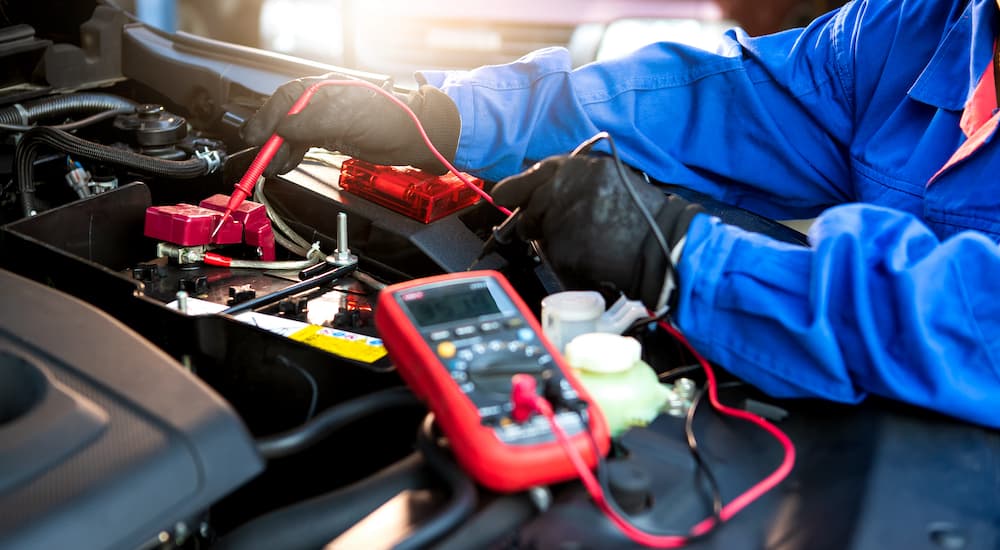Now that the holidays are behind us, we’ve all got new books to read, warm socks to wear, and maybe some new tires for our cars. And perhaps you’ve received a lovely new set of tools you’ve been hoping for, but what do you do now? How should you put those tools to use and not only save some money by skipping the mechanic but also get a new connection with, and appreciation for, your vehicle? If you’ve ever wanted to start working on your car and be able to do some simple maintenance and repairs yourself, then there’s no better time than now to go for it. Even if you’ve never worked on your vehicle before, here are some simple things to start with and discover just how satisfying it can be.
Get Familiar With Your Owner’s Manual
I sort of lied; before we get into any actual maintenance, there’s one thing you should start with: the owner’s manual. The manual for your vehicle is the single best source of information for your ride and what you need to know about it. If you’ve never really dug into it before, this is the time to look through it and discover everything it offers. You don’t have to read it cover to cover or anything, but take some time to familiarize yourself with it and discover what’s in there, so you know where to look when you have questions about your vehicle.
Learn to Inspect Your Vehicle
Next up, take some time to learn the ins and outs of your car and take a good look at it and its various parts. If you’re serious about working on your vehicle, it’s a good idea to get some blocks to lift it up safely so you can get under it while working on things. Using your owner’s manual, find out where the reservoirs for various fluids are in your vehicle, how to access your lights, and other basic things. Look at your wheels, tires, and suspension; get a sense of how it all comes together and the information you’ll need in the future, like the size of your wheels, the kinds of brakes you have, and much more. All this stuff will come in handy later, and it’s a great place to start; now, let’s talk about some actual maintenance.

Learn to Jumpstart Your Car
Jumpstarting a car is simple, though you need a second vehicle to do it. Put both cars in neutral and make sure they’re both turned off, then pop the hoods on both of them. You’ll need some jumper cables; it’s always best to be the hero with cables rather than hope someone else has some. You simply attach the red clip on each end to the positive terminal of the two batteries, then the black clip to the negative terminal of the good battery. Clamp the other black clip onto a clean, unpainted metal surface on the car getting jumped; a bolt head or bracket is a good choice. Start the engine in the troublesome vehicle; make sure you drive a bit before shutting it off so the battery can get recharged.
Change Your Oil
While jumpstarting a car is an emergency procedure, changing your oil is simple, regular maintenance that you should do on a set schedule. Get a pan under your engine where the drain plug is, remove the plug and unscrew your oil filter to let it drain out. Once empty of the old oil, return the filter and put the plug back on, then fill with new oil up to the appropriate amount. That’s it; pour the old oil into an empty bottle or similar container and take it to a garage that will recycle it for you. It’s a good idea to change your oil about every six months or 3,000 miles, though your manual will provide you with a more specific schedule.
Change a Tire
Changing your tires at home is pretty easy; start by using a wrench to loosen the lug nuts on the tire but don’t remove them. Use a jack to lift up your car, then take off the lug nuts and remove the tire. Now place the new tire onto your vehicle (you use this same process in an emergency when you need to put a spare tire on), then put your lug nuts back on. Lower your car from the jack, tighten the lug nuts, and you’re all set.
Change Your Spark Plugs
You typically only need to change spark plugs about every 100,000 miles, but if you’re having a hard time starting your car, a bad plug could be the culprit. Make sure your vehicle is off, then pop the hood and locate the spark plugs on your engine. Disconnect the spark plug wire, remove the spark plug, replace it with a new one, and reattach the wire. It’s best to do this with one spark plug at a time rather than take all of them out at once, especially if you discover you only need to replace one.
Replace the Battery
A dead battery is annoying; paying a mechanic a lot of money to replace a battery is even worse. You can use a volt meter to check if your battery is dead; if so, park your car on a flat surface and engage the parking brake. Pop the hood, locate your battery, and first remove the negative cable and clamp (this will be black), then the positive cable and clamp (this is the red one). Remove or loosen any screws, connectors, or fasteners holding the battery in place and lift up the old battery – these things are heavy, so be prepared.
Put in the correct replacement battery and do everything in reverse: secure it in place, connect the positive cable, then the negative, and finally, ensure the battery is secure. One thing to note: newer vehicles may have issues with their onboard computer after replacing the battery. Check your manual to see if you need to do something to reset things after a new-battery installation.

Replace Your Air Filter
Pop your hood and find the air filter box in your vehicle; it’s usually black and has a large hose coming out the side of it (again, your manual can help you here). Remove your old air filter from here, replace it with a new one that’s appropriate for your vehicle, close the box, and you’re done. This is incredibly simple, and doing this once each year or about every 12,000 miles will help keep your engine running beautifully.
Replace a Headlight/Taillight
Your owner’s manual will help you access your lights, they can be a bit tricky, and you may have to fiddle around a bit to get in there. Disconnect the wire from the bulb; sometimes, you’ll need to lift a tab to do this, then unscrew and remove the bulb. Now replace it with the proper type for your vehicle (once again: owner’s manual), reconnect the wire, replace any screws or fasteners used to hold things in place, and you’re done.
Where to Go From Here
As you can see, there are a lot of simple things that you can do, even if you have absolutely no experience working on a vehicle. The best part about all of this is that you’re sure to gain confidence as you perform these tasks and basic maintenance, so you’ll be ready to try some harder things in the future. Just be sure you have the right tools for the job; this is especially important when it comes to safety equipment and anything you need to support your vehicle while you work on it. You can get books and watch guides online or even take a maintenance class in your area to learn more. Just take things one step at a time and tackle each new project as it comes your way. Now, go change your oil and replace that air filter!

